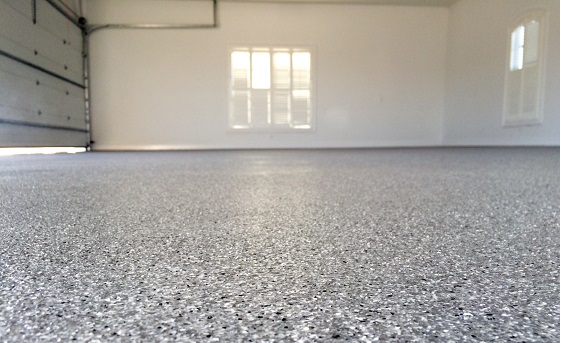Epoxy-coated garage floors are popular these days — and for good reason. I’ve always thought it was peculiar that builders would leave the concrete in a garage uncoated. They go to great expense to make sure that every surface in the home is perfect, but the garage floor, which is often used as the daily entrance to the house, is left uncoated. It’s no surprise that one of the first projects homeowners take on after moving in is finishing the garage floor.
These days, many big box retailers distribute epoxy coating options for the do-it-yourself (DIY) homeowner. It might be a cheaper option than hiring a professional coatings crew to apply the products — but is it the right choice?
For vinyl chip epoxy floors, at least, there are a few key differences between a DIY installation versus having it done by professionals.
Prep for Starters
Surface prep is a crucial step to any coatings job. If the surface doesn’t get the right profile before the coatings are applied, they are at risk for not adhering properly. Unlike steel surfaces, each concrete pour is created differently, which means surface preparation is critical for the success of a garage floor coating.
Even if they haven’t been coated before, most garages have already been treated with some sort of sealer. That, at the very least, will need to be removed, and the concrete will need to be roughened up before anything new can be added to the floor. That requires some kind of concrete grinder.
Although big box stores might also offer equipment that could work for this step, not all of the available equipment will be strong enough to get the job done in a timely manner. Contractors can speed up the process and dig in more efficiently by using larger commercial grinders. Or, if those aren’t an option, contractors know how to add weights to smaller grinders to add more head pressure. Homeowners may be able to do this, too, but a rental store might not like it if weights are added to the grinders.

Knowing what profile is needed for the system is also key during this step. And, professionals have knowledge up their sleeves that throwing sand on the floor may help to keep the sealer from sticking to the grinder’s diamonds.
Solid Step
Epoxies are made of two different materials, which means that they need to be mixed together at the correct ratio, speed, etc. Not all epoxies are created equally, so if they’re mixed improperly, they may not cure out correctly.
The epoxy kits that homeowners can typically get at a big box store are usually water-based and made with around 50 percent solids. That means that half of what is poured on the floor will evaporate into the air — and what doesn’t evaporate will end up being fairly thin. On the other hand, pros may be using a 100 percent solids epoxy product, and some of those even have moisture vapor properties built in. Having 100 percent solids means that twice as much of the product as what the homeowner would be applying needs to be applied, in order to cover the same amount of square footage. This will result in a thicker, more durable coating, but it also comes with a higher price tag.
Reject vs. Accept
To get a colorful finish, flakes (or chips) are often used in the wet coating. Pros are probably going to broadcast the chips to rejection, which adds traction and a better look than a partial broadcast of chips — that’s what the DIY kits suggest. The pros also have the ability to use different color combos than might be in a one-size-fits-all type of kit.
Clean and Clear
On day two of a typical epoxy garage floor project, a professional crew would be working to prepare the floor to receive a clear polyaspartic urethane topcoat. Using professional-grade application equipment (including rollers and spiked shoes) and proper safety gear helps them to apply this seamless floor. Because the DIY kit again offers a water-based product that will evaporate by 50 percent, the professional’s product usually ends up being eight times thicker than what comes from a DIY kit, once it’s cured out.
Paying the Price
More materials, bigger equipment, and more time can add up. Not everyone wants to spend a few thousand dollars in the garage, and that’s completely understandable. But it might be worth paying the price tag to a coating professional up front if it means not having to pay the price down the line. You may be avoiding the need for them to come out later to remove and replace a DIY system.

There is a huge difference in what professionals use and what clients can get at a local DIY store. The tradeoff just might be worth it, once the final product is taken into account.
This content was originally published on YouTube on January 19, 2021. Republished with permission.
About the Author:
Tim Seay is the co-owner of Decorative Concrete of Virginia. For more information, contact: Tim Seay, www.decorativeconcreteofvirginia.com or www.youtube.com/timdcva